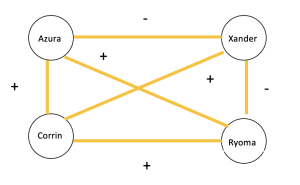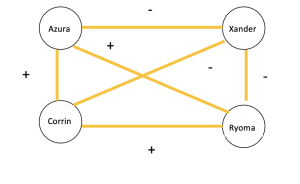Your Choices Decide Your Fate – Fire Emblem and Structural Balance
Fire Emblem is a fantasy tactical role-playing game series published by Nintendo. Many of its characters (and I mean many) are featured in the well-known game Super Smash Bros Ultimate. One of these characters is Corrin, the protagonist from the game Fire Emblem Fates for the Nintendo 3DS. In the universe of Fates, there are two major countries: the peaceful Hoshido and the glorious Nohr. Early on in the game, Corrin must make a decision that will change their life: what country will they side with?
Initially, before Corrin has to make a decision, they have the following relationships with three characters: Xander, Ryoma, and Azura. Xander is a prince of Nohr and has known Corrin since they were young and thus have a positive relationship. Ryoma is a prince of Hoshido and is related to Corrin by blood and thus have a positive relationship with each other. Azura is a princess of Hoshido and has a special bond with Corrin and thus have a positive relationship.
Additionally, the following will be assumed:
- Characters from Nohr have a negative relationship with character from Hoshido since the countries are entering war against each other.
- Characters with the same allegiance have a positive relationship with each other.
The graph below shows the initial relationships between the characters before Corrin makes a decision.
This graph is unbalanced and thus violates the structural balance property. An example of a violation is between Corrin, Xander, and Ryoma. Corrin has a positive relationship with Xander and Ryoma because Corrin sees both of them as family. However Xander and Ryoma are on opposing sides of a rising conflict and thus have a negative relationship.
Corrin’s decision on who to side with makes the graph balanced. If Corrin decides to side with Hoshido, then the relationship between Corrin and Xander has turned sour and thus is now negative. The graph below shows the relationships between the characters when Corrin chooses Hoshido.
This graph is now balanced and satisfies the structural balance property for each set of three people. The Balance Theorem is also intact here — the people can be divided into two groups: Hoshido (Corrin, Azura, and Ryoma) and Nohr (Xander).
If Corrin decides to side with Nohr instead, then the relationship between Corrin and Ryoma has turned sour and thus is now negative. Surprisingly, the special bond between Corrin and Azura keeps them together. Thus, Azura decides to join Corrin. Consequently, the relationship between Azura and Ryoma turns negative. Additionally, Azura learns to accept Xander since they both have a positive relationship with Corrin.
This graph is now balanced and satisfies the structural balance property for each set of three people. The Balance Theorem is also intact here — the people can be divided into two groups: Hoshido (Ryoma) and Nohr (Corrin, Azura, Xander).
The relationships between these characters in Fire Emblem Fates emphasize how structural balance works through its in-game conflict.
Source:
Fire Emblem Fates, Intelligent Systems, Nintendo, 2016, https://www.nintendo.com/store/products/fire-emblem-fates-conquest-3ds/



